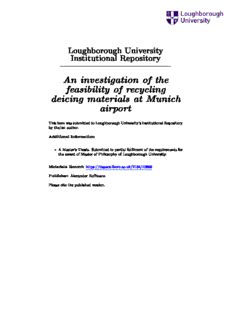
An investigation of the feasibility of recycling deicing materials at Munich airport PDF
Preview An investigation of the feasibility of recycling deicing materials at Munich airport
Loughborough University Institutional Repository An investigation of the feasibility of recycling deicing materials at Munich airport ThisitemwassubmittedtoLoughboroughUniversity’sInstitutionalRepository by the/an author. Additional Information: • AMaster’sThesis. Submittedinpartialfulfilmentoftherequirementsfor the award of Master of Philosophy of Loughborough University. Metadata Record: https://dspace.lboro.ac.uk/2134/10686 Publisher: Alexander Hoffmann Please cite the published version. This item was submitted to Loughborough University as a Masters thesis by the author and is made available in the Institutional Repository (https://dspace.lboro.ac.uk/) under the following Creative Commons Licence conditions. For the full text of this licence, please go to: http://creativecommons.org/licenses/by-nc-nd/2.5/ I • Lo1;1ghb_orough • Uruvers1ty Pllklngton Library '±~~~I· .A Author/Filing Title . ......... f Accession/Copy No. Vol. No ....•.... Class Mark ..... . id a si I ~ 0401661067 1111111111 • AN INVESTIGATION OF THE FEASIBILITY OF RECYCLING DEICING MATERIALS AT MUNICH AIRPORT by ALEXANDER HOFFMANN A MASTER'S THESIS SUBMITTED IN PARTIAL FULFILMENT OF THE REQUIREMENTS FOR THE AWARD OF MASTER OF PHILOSOPHY OF LOUGHBOROUGH UNIVERSITY ©by Alexander Hoffmann 1998 I - U .... ,~v Luugt;1Yctoogn Unrv::r~ity Pi: . -.·' "':'".:.l.l'.Y.- -- ~~. "'f Da~ (),A. ~ 4 ••• - ... -·- Cl:b.i ...,.,.,._ .... _..,._ A&c No. D'\-o( bblo~ ·' Abstract The growing public awareness and sensitiveness towards environmental protection increases significantly the pressure upon the a1r transport industry to implement regulatory measures for the operation of both airports and aircraft. With regard to the feasibility of recycling deicing materials and the requirement to achieve compatibility between a deicing concept and a fluid recycling concept, many airports are isolated with insufficient guidelines for developing an appropriate decision making process. Regretably at present only informations exists, which deals with the dedicated issues and problems concerning a1rcraft deicmg, airport deicing and the disposal of fluids. Also, diffenng international and national regulations concerning environmental protection have impeded the development of generic strategies. As Mun1ch International Airport has Implemented a specialized concept of aircraft/airport deicing and fluid recycling with the opening of the airport m 1992, the decision to investigate its operational, environmental and economic performance in this thesis was simple and obvious. However, aircraft/airport deicing is an international issue, which affects many airport and airlines around the world. Consequently, a generic strategy would be of general interest. Although the Munich case is the basis for this thesis,. i.n ternational operational aspects and environmental issues are also discussed with a view to drawing conclusions for the establishment of a genenc strategy. The major conclusions concern the need to improve existing environmental legislation and to harmonize these legislative measures in order to achieve a general applicable international standard worldwide. There is no perfect alternative- no one solution to fit every size of airport. Differing international environmental regulations and. sta.n dards concerning fluid . disposal and environmental impact demand diversified investigations which subsequently may lead to totally different solutions for an individual airport operator. The recommendations and suggested generic strategies contained in this thesis are only to be seen as a guideline for any decision making process an airport operator may suddenly be confronted with. L------------------------------------------------------------------------ - - In memorial to my father Dr. Max Hoffmann who continuously encouraged me over many years to undertake and complete my studies at Loughborough University. To my dear wife Annette for her pat1ent and caring support and understanding. Page Abstract Contents Preface: -List Of Figures i i -List Of Tables i i i Note 1 Rationale For The Study 2 Chapter 1: The Need For Deicing Aircraft And Its 6 Consequences - Ground deicing/anti-icmg operations at airports 10 - Conditions under wh1ch icing occurs 11 - The airports snow and ice plan - the 17 predictability/forecasting of 1cing conditions - Relative pollution strength of deleing 20 chemicals - Effects on the environment 21 - Runway glycol contamination 24 - History of deicing methods 27 - History of aircraft de-/anti-icing fluids 30 Chapter 2: (Methods Of Aircraft Deicing 32 - Centralized deicing facilities 33 - Current operating procedures and practices 38 - methods of fluid application on aircraft 40 surfaces - Anti-icing treatment after aircraft arrival at 42 the gate - Operational requirements 43 - Health and safety issues 44 - Technologies available 46 Chapter 3: Impact Of Deicing Activities On The 51 Environment - Environmental effects of ground deicing and 51 relative pollution strength - The fate of aircraft deicing fluid after 57 application - Sources and pathways for entering the 59 environment - Impact of urea 63 - Impact of tarmac deicing activities 67 - Consumption of tarmac deicing fluids 69 Chapter 4: Potentials For Reducing Degree Of 72 Environmental Impact - Chemical usage minimization strategies 74 - Reduction of application rates 75 - Reduction of operational rates 77 i .. '
Description: